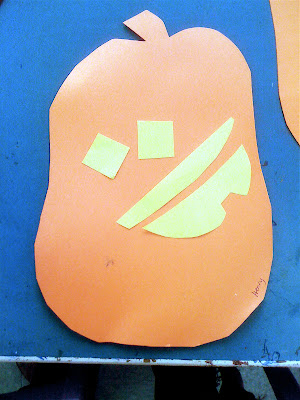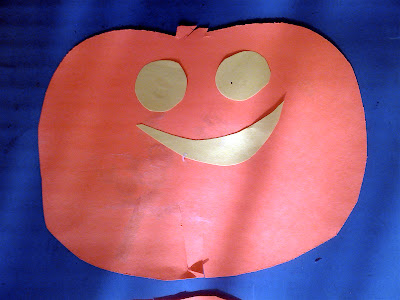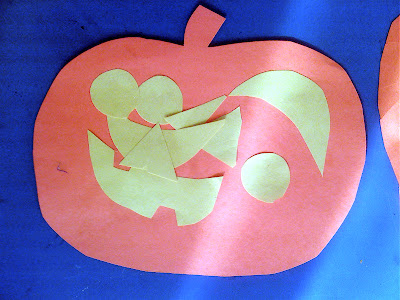You have your way. I have my way. As far as the right way, the correct way, and the only way, it does not exist. ~Friedrich Nietsche
We've been using pre-cut pumpkin shapes, pre-cut yellow shapes, sheets of orange and yellow construction paper, scissors, and glue sticks at the art table for the past couple days. Classic preschool stuff: construction paper jack-o-lanterns. I sold the whole thing as making decorations for our upcoming Halloween party, which, in fact, is how I intend to use them.

We guide them at first, of course, especially the youngest ones with very little experience with things like scissors and glue. We owe it to them to provide an example of what these tools can do, and the best way to do that is to just make something of your own with the materials, narrating what you're doing. If possible, I like the kids to have the tools in their hands at the same time. I figure our best bet for learning what we need to know about a new tool is to try to marry our narrating and demonstrating with a child's own hands-on experimentation. I've made enough art in my life to know that it's helpful to get some initial guidance from someone with more knowledge, but experience is the only way to become proficient with a tool. And it's only through proficiency that one can finally fully express oneself.

So there is, at least at some level, a "right way" to use a tool, at least if you want to get it to do what it was intended to do. If you want more glue stick, for instance, you'll probably need to learn about turning the little knob at the bottom of the tube. If you're using scissors, you'll probably need to know that the business part is where the blades intersect (you don't need to know that that intersection moves at the speed of light, but it's interesting). I'll help you figure out how to ride a bike, but where you go with it is up to you.
What you do with that tool, where you go with it: there's no correct answer to that question. At bottom that's what we're talking about when we say, "open-ended art," or "play-based curriculum." It's a place where there is no right way or wrong way, but rather tools, materials, consideration for the other people, and time to explore.
I understand that we live in a kind of bubble here at Woodland Park. So immersed are we in what we do that it's easy to forget that we're still considered rather radical. I overhear us described as "that crunchy granola school," or "hippie school," or "a place where the kids run wild." I forget that there's is a big, wide world out there full of children being taught the right way and the wrong way by well-intended adults, hoping I guess to inoculate them against mistakes, but instead, I fear, infecting them with the disease of perfectionism.
When we manage to teach children that there is a right way and a wrong way, they are learning something about black and white. They are learning something about their own judgement. They are learning something about rote and
obedience. And I think none of it good, at least if the idea is to have them ultimately emerge from school as people who form their own ideas and have the courage to express them.

Each of you, for himself, by himself and on his own responsibility, must speak. And it is a solemn and weighty responsibility, and not lightly to be flung aside at the bullying of the pulpit, press, government, or the empty catchphrases of politicians. Each must for himself alone decide what is right and what is wrong, and which course is patriotic and which isn't. You cannot shirk this and be a man. To decide against your convictions is to be an unqualified and inexcusable traitor, both to yourself and to your country, let man label you as they may. If you alone of all the nation shall decide one way, and that way be the right way according to your convictions of the right, you have done your duty by yourself and by your country -- hold up your head! You have nothing to be ashamed of. ~Mark Twain
The "right way" teaches that those with more power know best. The "wrong way" teaches shame. If the right way doesn't come from within, it's just another rule to obey, but as Twain points out there's one step more that we must consider, it's not enough to simply form your own convictions, but one must have the courage to express them as well. And the thing that stops too many of us, the block, I think, is fear of the wrong way.
Moral cowardice that keeps us from speaking minds is as dangerous to this country as irresponsible talk. The right way is not always the popular and easy way. Standing for right when it is unpopular is a true test of moral character. ~Senator Margaret Chase Smith
I recall in kindergarten being not only instructed to color inside of the lines, but to only employ horizontal strokes with the crayon. I don't know how much this kind of education shaped me: I feel I've always formed my own opinions. But I'm definitely late to the game when it comes to expressing them out loud, overcoming my fear of being unpopular, of being a trouble-maker, of being a laughing stock, of being wrong. Mockery was always the best way to make me cringe and doubt and pull my head back into my shell. But the more I've worked with children and their parents, the bolder I've become, the more I've sought to role model the habits of free thought and action that I want to see in both myself and the rest of the world.

That's why I don't think it's out of place to occasionally use this blog space to express, as clearly as I can,
my own political thoughts, my support for things that may not be popular. I keep hearing people complain that Americans don't care enough, that we're too absorbed in our reality television or something to engage. And that may be true, but as I see it, the greatest crisis we face in our democracy today is not apathy, but fear of the wrong answer, of making a mistake, of being mocked or shouted down. I hope that my example, not my opinions themselves, but the example of speaking out, will motivate you to engage more fully with the tools of self-governance, which in turn you will pass on to the children in your life.
As I look at these pumpkin faces the children have made, each according to her or his own internal vision, according to his or her capability with the tools, I think I see the habit of fearlessness I hope they are learning here at Woodland Park.
I love how boldly they've signed their names to them, saying clearly and proudly, This is what I made. One of the "pumpkins" not pictured here is one made by River, which looked to me like a piece of yellow paper he had simply torn in half. He showed it to me, saying, "I'm putting this in my cubby to show my mom and my brother."
I would like to be open with the public. I would like to not keep secrets or be careful when I talk. I don't want to have to plan things . . . I want to be outspoken. I want to say my opinions and hope they're taken in the right way. I don't want to stop being free. And I won't. ~Angelina Jolie
I know that there are teachers out there, parents, and other adults who would have insisted that River's torn paper was the wrong way, who would have shoved some scissors in his hand and "taught" him the right way, when perhaps what he's expressing with this "pumpkin face" is something that says, I don't need your tools or pre-cut shapes to say what I have inside. And in letting him know he's wrong, in correcting him, in judging his expression unpopular, we teach him to doubt himself, which is a way of making him a little less free.
I'm probably making too much of these pumpkin faces. Every preschooler makes them. But seeing them here like this, these decorations we made for our school, I can't help but hope that no one ever tells them that they did it the wrong way; or perhaps even worse, I think, show them the right way.
Just remember, there's a right way and a wrong way to do everything and the wrong way is to keep trying to make everybody else do it the right way. ~Colonel Potter (MASH)
I put a lot of time and effort into this blog. If you'd like to support me please consider a small contribution to the cause. Thank you!